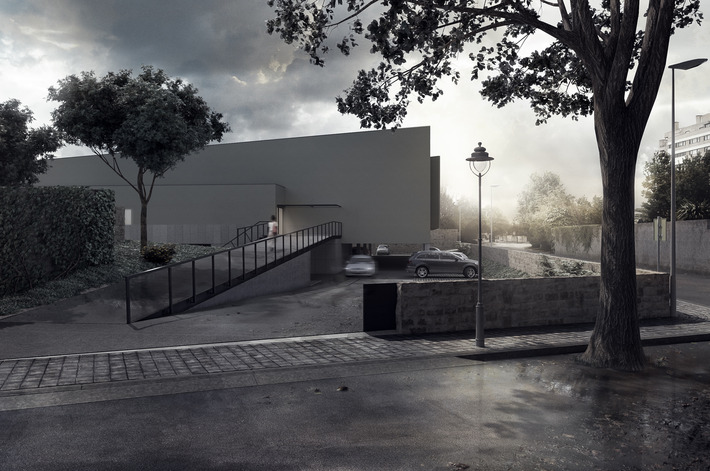- Blog
- Interviews
- Okdraw, The Realistic And Detailed Architectural Model Wonderteam!
25 Mar 2016
Okdraw, The Realistic And Detailed Architectural Model Wonderteam!
Interviews

Say hello to Okdraw, an ambitious team of architectural modelers. It's a two man team, so you could even call them a dynamic duo! We gave them a few questions and they told us all about architectural modeling and exacting detail in models.
We're a two-man team of an architect and a product designer who love to create new worlds, spaces and objects.
We both started modeling in 3D out of necessity to complement our works (the architecture and product design).

Realistic architectural rendering came out naturally, as we almost always need to create buildings, streets, or other architectural structures, and we also need products, such as furniture, street equipment, small decorative objects, etc. This complements our fields of study and work, which is perfect and works great.
We're both a little obsessed with the details, so it only made sense to work towards realistic renders, instead of a more artistic approach. This is not always possible either because the client doesn't want it, or due to time constraints, but we always try to add as much detail as we are allowed to.
Our work always starts with gathering photograph references of isolated materials, then some references of the materials in some context, pictures from perspectives that we think that could beautify the subject, and finally some mood/environment examples.
For the materials we always try to stick to photographic instead of CG references. This allows us to be more faithful to realism.
When it comes to the modeling part, we always try to have some guide of measures, or some spec sheets of the furniture/models we're making.
In conclusion, you need to constantly check your work against the real world.

Most of our marketing is based on the good old word of mouth. A happy client will always recommend you to a colleague. Besides that, we try to do the regular marketing on social media and email marketing. From time to time we go on personal meetings with ateliers that could gain benefit from our services.
You have to always do your best for every job, no matter how much you're paid, and always be professional about everything.
To be honest, the thing we enjoy the most is the freedom it allows you to have. You can work from nearly anywhere, with any kind of client, all of which expands your marketing and income range. At the same time, you don't have to worry about creative or technical issues, and you are allowed to create new worlds, “travel” to places you've never been before and play with light, materials and shapes.
That's a tough question. We actually can't remember a moment like that, maybe it's still yet to come.
The hardest part is probably the fact that as a 3D designer, we are the last people to work on a project. This means that our deadlines are normally very tight and don't allow us to go overboard on details, as we would like to do. This also places a lot of hopes and stress on our work, especially if the client needs to make last minute alterations.

We started with Artlantis, but we soon realized that it didn't have what we felt we needed to do our job the way we wanted to. We switched to 3d studio max, which we were already familiar with, and we've stayed faithful to 3ds max ever since. The initial render engine was Mental-ray, but we noticed that V-ray had more options and quality, so we ended up only using Mental-ray for one job. In the last year we've switched from V-ray to Corona, and the reason for that was the license cost, the progressive rendering engine and the speed. For image editing we use Photoshop and Lightroom for the final image adjustments.
Right now, we're making some images for an apartment tower with a gym in Portugal, we've scheduled two product animations for Germany and an architecture competition for Switzerland. We also have an interactive surprise project to announce in Unreal engine 4.
That's a hard question. We always feel that we can do better and better, no matter how good the project is, and we are never completely satisfied with our work. In the end we think that Ohporto Apart hotel would probably be the closest thing to our “magnum opus”. We still have an extension of that project to publish, that we think it's going to be a very nice project. Stay tuned for that new project!

We don't know if it's that impressive now, but back in 2014 we were very impressed by the work of a fellow Portuguese artist called Jacinto Monteiro” The first work that impressed us was “treevillas”. At that time, it was impressive to see that all the dirt, the small branches, the wild grass, pretty much all the nature around the house was modeled. We were lucky to get a glimpse of his work in the “making of” at “Ronen Bekerman”.
Then we also have the “Nakagin Capsule Tower” of Bertrand Benoit, it is simply mind blowing. You really have to watch his work and his making of.
Maybe the “Tourette church” by “Le Corbusier”, because the interior is a bit dark, but the colors on the windows, the light and some other color details really make the contrast interesting.

Right now we have some mixed feelings about it. The concept and potential is huge and it will definitely be a thing in a long-term future, however, right now, the cost of working and presenting a proper VR project to a client is crazy. Just the headset can cost you 400€ and it's just an impractical way to demonstrate stuff to a client. It's not like you can send the files to the client and expect him to have a VR headset.
Right now, we think that interactive 3D projects might be the next big thing, but the VR still needs a couple of years to settle in and to become more mainstream. When that happens, it will obviously mean that a client will be able have a experience the project in depth and make changes on the fly, which will help architects to show their intentions and true art.
Please finish the following sentences (be as honest as you can.. : )
Our greatest inspiration is… to see an image and question whether it’s a photograph or a render.
We abandon some of our works because… we are dreaming, we never abandon works.
When we catch ourselves procrastinating, we… take a break for a coffee.
We‘re most productive when… we take coffee.
We take a break from our work when… we want to take a coffee, or we've just received bad news. As you can see, coffee rules everything around us.
Comments